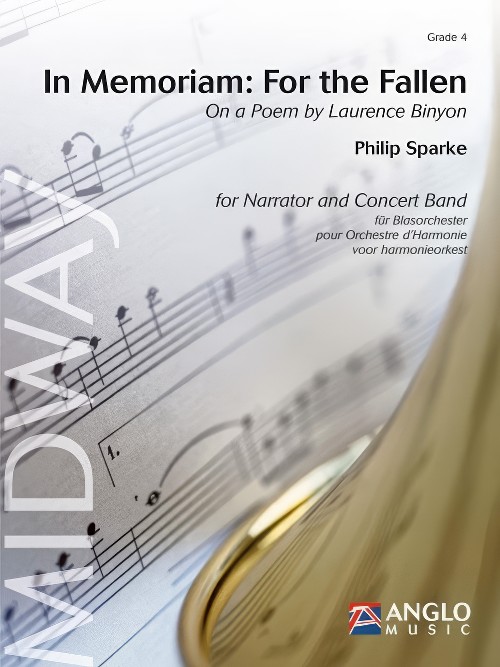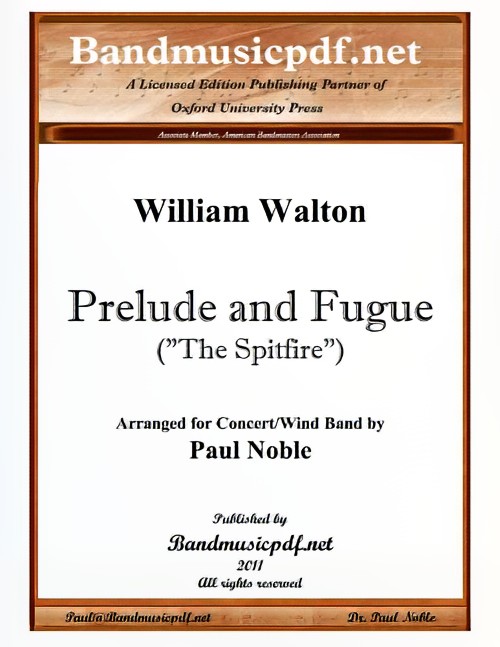Results
-
 £113.00
£113.00Eternal Vigilance (The Long Brave Line) - Robert Jager
The result of a collaborative commission by the U.S. Air Force Academy Band, the U.S. Coast Guard Band, the U.S. Military Academy Band and the U.S. Naval Academy Band, this major work for band takes its title from a quote attributed to Thomas Jefferson, Eternal vigilance is the price of liberty, and a variation of the West Point motto, The Long Gray Line. Opening with a tribute to those who have gone before in service to our country, a solemn, noble theme is presented that reappears near the end of the composition. The main body of the work is a series of march-like themes and idiomatic fragments culminating in a glorious full-band fanfare. Following a restatement of the noble theme, a stirring coda brings the music to a climactic close. Dur: 8:30 (Grade 5) (E.B. Marks)
Estimated dispatch 7-14 working days
-
 £152.99
£152.99In Memoriam: For the Fallen - Philip Sparke
In Memoriam: For the Fallen was commissioned by Bolsover District Council for the Bolsover Brass Summer School 2014. It is a setting for narrator and band of Laurence Binyon's (1869-1943) poem, For the Fallen, which was first published in The Times in September 1914. Binyon was dismayed at the outbreak of war and especially concerned by the large number ofcasualties suffered by the British Expeditionary Force in the early months of the battle on the Western Front. Too old to enlist, he volunteered as a hospital orderly in France. The poem is known world-wide as the famous fourth stanza (They shallgrow not old...) has become a regular part of Remembrance Day and ANZAC Day services.In Memoriam: For the Fallen is a musical accompaniment to the poem, shadowing the mood of each stanza.
Estimated dispatch 7-14 working days
-
 £104.99
£104.99The Ultimate EUROPE Collection
The Ultimate "Europe" Collection is an exciting medley of explosive 80s rock! Europe, who originally went under the name of Force, were founded in 1979 in the Swedish town of Uppland Vsby. At the beginning the band wrote progressive rock but soon switched their direction to a more accessible, keyboard-laden rock sound. Their worldwide breakthrough came in 1986 with the snappy The Final Countdown. This infectious rock number occupied the number one slot in the charts the world over. At the end of the 80s Europe had various other hits, of which Rock the Night, Carrie and Superstitious are the best known. The band, which over time has released eightstudio albums, is still going strong and has a loyal fan base. In The Ultimate "Europe" Collection four of the biggest of Europe's hits are brought together: The already-mentioned Rock the Night, Carrie and Superstitious and of course also the megahit The Final Countdown !
Estimated dispatch 7-14 working days
-
 £174.99
£174.99The Legend of Flathead Lake - Carl Wittrock
In Scotland, the monster of Loch Ness is a hot issue, but the American state of Montana enjoys a comparable phenomenon going by the name of Montana Nessie. In the western part of this remote state lies Flathead Lake: a lake of 45 kilometres /38miles in lenght and 24 kilometres /15 miles breath. At several places, its depth exeeds 100 metres.Nessies discovery takes us back to the year 1889, when captain James Kerr aboard the passengership U.S.Grant was startled by a ship unknown to himsuddenly approaching his vessel across Flathead Lake. However, it turned out not to be a ship but an undefinable animal of immense size.From that moment onwards, life would never be the same again in and around Flathead Lake.The composer wasinspired by the story, and summarized the events into a symphonic poem, but from a surprising angle:that of the monster. The exiting opening allows us to follow the monster in its natural surroundings.The fast follow-up movement depictsMontana Nessie trotting and frolicking about the Montana woods and prairies.From its abode, it thorougly enjoys everything around it. This period abruptly ends in a short climax (Chimes). The solo for cor anglais marks a new period in themonsters life.The presence of people has a paralizing effect and the apprehensive atmosphere of the slow movement may be felt profoundly.The monster observes and mildly teases the ship. Abhor sounds force the ship to a withdrawal.The movingmusical continuation depicts the triumphant monster dancing an ironic waltz. The monsters fear and anger at the intrusion of his freedom run through the piece like continuous threads, and develop into the works final theme.
Estimated dispatch 7-14 working days
-
 £154.99
£154.99The Power of the Megatsunami - Carl Wittrock
The word 'tsunami' is of Japanese origin. When you look it up in a dictionary, you will find that it means 'a great sea wave produced by submarine earth movement or volcanic eruption'. A megatsunami is the superlative of this awesome expression of power that nature can create, and has catastrophic consequences. When Carl Wittrock completed this composition not many such big earth movements had occurred, but since then we have become all too familiar with the disastrous consequences which a tsunami may have. On the 26th of December 2004 a heavy seaquake took place near the Indonesian island of Sumatra. Tidal waves 10 meters in height ravaged the coastal regions ofmany countries for miles around. The tsunami took the lives of thousands of people and destroyed many villages and towns. There are more areas which run the risk of being struck by a tsunami, such as the island of La Palma, one of the Canary Islands. This island is based on oceanic crust at a fracture zone and as such is one of nature's time bombs. The consequences of a natural calamity like a megatsunami are immense. In the case of La Palma, the tidal wave will move in the direction of South America, where it may reach 50 km inland, destroying everything on its way. In his composition Wittrock describes an ordinary day which will have an unexpected ending. Right from the beginning there seems to be something in the air, the music creating an oppressive atmosphere of impending disaster. Themes are interrupted, broken off suddenly, followed by silence, suggesting the calm before the storm. Suddenly a short climax (glissandi in the trombone part) indicates the seaquake, and the megatsunami is a fact. Hereafter follows a turbulent passage symbolising the huge rolling waves. After nature's force has spent itself, resignation sets in and the composition ends with a majestic ode to nature.
Estimated dispatch 7-14 working days
-
 £152.99
£152.99In Memoriam: For the Fallen (Narrator with Concert Band - Score and Parts) - Sparke, Philip
In Memoriam: For the Fallen was commissioned by Bolsover District Council for the Bolsover Brass Summer School 2014. It is a setting for narrator and band of Laurence Binyon's (1869-1943) poem, For the Fallen, which was first published in The Times in September 1914. Binyon was dismayed at the outbreak of war and especially concerned by the large number of casualties suffered by the British Expeditionary Force in the early months of the battle on the Western Front. Too old to enlist, he volunteered as a hospital orderly in France. The poem is known world-wide as the famous fourth stanza (They shall grow not old...) has become a regular part of Remembrance Day and ANZAC Day services. In Memoriam: For the Fallen is a musical accompaniment to the poem, shadowing the mood of each stanza.Duration: 7.30
Estimated dispatch 7-14 working days
-
 £140.00
£140.00Prelude and Fugue (The Spitfire) (Concert Band - Score and Parts) - Walton, William - Noble, Paul
The Prelude and Fugue (The Spitfire) by William Walton, written to accompany the film, The First of the Few, was the film story of the designer of the Spitfire fighter aircraft, R. J. Mitchell. This work was lifted, almost bodily out of the film score: exceptionally (for film music) it needed hardly any modification to turn it into a first-rate concert piece. The prelude, called by Stephen Lloyd one of Walton's finest marches, is the music heard over the opening credit titles in the movie. A central lyrical solo depicts the exhaustion and dying by illness of the aircraft's designer R. J. Mitchell. The fugue is used to describe the making of the Spitfire, and then the patriotic march returns joined with the fugue to mark the completion of the fighter aircraft. The majestic march-like drama of the Prelude is well-suited for graduation and other ceremonial events, and the total piece is a tour de force for contest performance.
Estimated dispatch 7-14 working days
-
 £113.00
£113.00Eternal Vigilance (The Long Brave Line) (Concert Band - Score and Parts) - Jager, Robert
The result of a collaborative commission by the U.S. Air Force Academy Band, the U.S. Coast Guard Band, the U.S. Military Academy Band and the U.S. Naval Academy Band, this major work for band takes its title from a quote attributed to Thomas Jefferson, "Eternal vigilance is the price of liberty," and a variation of the West Point motto, "The Long Gray Line." Opening with a tribute to those who have gone before in service to our country, a solemn, noble theme is presented that reappears near the end of the composition. The main body of the work is a series of march-like themes and idiomatic fragments culminating in a glorious full-band fanfare. Following a restatement of the "noble" theme, a stirring coda brings the music to a climactic close.Duration: 8:30
Estimated dispatch 7-14 working days
-
£174.99
The Legend of Flathead Lake Wind Band Set (Score & Parts)
In Scotland, the monster of Loch Ness is a hot issue, but the American state of Montana enjoys a comparable phenomenon going by the name of Montana Nessie. In the western part of this remote state lies Flathead Lake: a lake of 45 kilometres /38 miles in lenght and 24 kilometres /15 miles breath. At several places, its depth exeeds 100 metres.Nessies discovery takes us back to the year 1889, when captain James Kerr aboard the passengership U.S.Grant was startled by a ship unknown to him suddenly approaching his vessel across Flathead Lake. However, it turned out not to be a ship but an undefinable animal of immense size.From that moment onwards, life would never be the same again in and around Flathead Lake.The composer was inspired by the story, and summarized the events into a symphonic poem, but from a surprising angle:that of the monster. The exiting opening allows us to follow the monster in its natural surroundings.The fast follow-up movement depicts Montana Nessie trotting and frolicking about the Montana woods and prairies.From its abode, it thorougly enjoys everything around it. This period abruptly ends in a short climax (Chimes). The solo for cor anglais marks a new period in the monsters life.The presence of people has a paralizing effect and the apprehensive atmosphere of the slow movement may be felt profoundly.The monster observes and mildly teases the ship. Abhor sounds force the ship to a withdrawal.The moving musical continuation depicts the triumphant monster dancing an ironic waltz. The monsters fear and anger at the intrusion of his freedom run through the piece like continuous threads, and develop into the works final theme. 12:00
Estimated dispatch 7-14 working days
-
£154.99
The Power of the Megatsunami Wind Band Set (Score & Parts)
The word 'tsunami' is of Japanese origin. When you look it up in a dictionary, you will find that it means 'a great sea wave produced by submarine earth movement or volcanic eruption'. A megatsunami is the superlative of this awesome expression of power that nature can create, and has catastrophic consequences. When Carl Wittrock completed this composition not many such big earth movements had occurred, but since then we have become all too familiar with the disastrous consequences which a tsunami may have. On the 26th of December 2004 a heavy seaquake took place near the Indonesian island of Sumatra. Tidal waves 10 meters in height ravaged the coastal regions of many countries for miles around. The tsunami took the lives of thousands of people and destroyed many villages and towns. There are more areas which run the risk of being struck by a tsunami, such as the island of La Palma, one of the Canary Islands. This island is based on oceanic crust at a fracture zone and as such is one of nature's time bombs. The consequences of a natural calamity like a megatsunami are immense. In the case of La Palma, the tidal wave will move in the direction of South America, where it may reach 50 km inland, destroying everything on its way. In his composition Wittrock describes an ordinary day which will have an unexpected ending. Right from the beginning there seems to be something in the air, the music creating an oppressive atmosphere of impending disaster. Themes are interrupted, broken off suddenly, followed by silence, suggesting the calm before the storm. Suddenly a short climax (glissandi in the trombone part) indicates the seaquake, and the megatsunami is a fact. Hereafter follows a turbulent passage symbolising the huge rolling waves. After nature's force has spent itself, resignation sets in and the composition ends with a majestic ode to nature. 10:30
Estimated dispatch 7-14 working days
